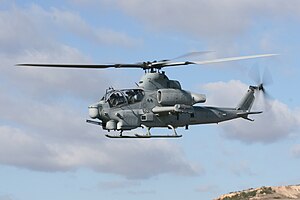Bell AH-1Z Viper
For an overview of the whole Huey family of aircraft, see Bell Huey.
| AH-1Z Viper | |
|---|---|
| An AH-1Z from HMLAT-303 at Camp Pendleton | |
| Role | Attack helicopter |
| National origin | United States |
| Manufacturer | Bell Helicopter |
| First flight | 8 December 2000 |
| Introduction | September 2010 |
| Status | In service, in production |
| Primary user | United States Marine Corps |
| Unit cost | US$27 million[1] US$31 million (new built)[2] |
| Developed from | Bell AH-1 SuperCobra |
Development
Background
Aspects of the AH-1Z date back to the Bell 249 in 1979, which was basically an AH-1S equipped with the four-blade main rotor system from the Bell 412. This helicopter demonstrated Bell's Cobra II design at the Farnborough Airshow in 1980. The Cobra II was to be equipped with Hellfire missiles, a new targeting system and improved engines. Later came the Cobra 2000 proposal which included General Electric T700 engines and a four-blade rotor. This design drew interest from the US Marine Corps, but funding was not available. In 1993, Bell proposed an AH-1W-based version for the UK's new attack helicopter program. The derivative design, named CobraVenom, featured a modern digital cockpit and could carry TOWs, Hellfire or Brimstone missiles. The CobraVenom design was altered in 1995 by changing to a four-blade rotor system. The design lost to the AH-64D later that year however.[5]H-1 upgrade program
In 1996, the USMC launched the H-1 upgrade program by signing a contract with Bell Helicopter for upgrading 180 AH-1Ws into AH-1Zs and upgrading 100 UH-1Ns into UH-1Ys.[5][6] The H-1 program created completely modernized attack and utility helicopters with considerable design commonality to reduce operating costs. The AH-1Z and UH-1Y share a common tail boom, engines, rotor system, drive train, avionics architecture, software, controls and displays for over 84% identical components.[7]Bell participated in a joint Bell-Government integrated test team during the engineering manufacturing development (EMD) phase of the H-1 program. The AH-1Z program progressed slowly from 1996 to 2003 largely as a research and development operation.[5] The existing two-blade semi-rigid, teetering rotor system is being replaced with a four-blade, hingeless, bearingless rotor system. The four-blade configuration provides improvements in flight characteristics including increased flight envelope, maximum speed, vertical rate-of-climb, payload and reduced rotor vibration level.[8]
The AH-1Z first flew on 8 December 2000.[9] Bell delivered three prototype aircraft to Naval Air Systems Command (NAVAIR) at Naval Air Station Patuxent River in July 2002, for the flight test phase of the program. Low-rate initial production began in October 2003,[5] with deliveries to run through 2018.[10] In February 2008, the United States Navy adjusted the contract, with the last 40 AH-1Zs to be built as new airframes instead of the previously planned rebuild of AH-1Ws.[11] In September 2008, the Navy requested an additional 46 airframes for the Marine Corps, bringing the total number ordered to 226.[12] In 2010, the Marine Corps plans to order 189 AH-1Zs with 58 of them being new airframes,[13] with deliveries to continue until 2019.[14] On 10 December, the Department of the Navy approved full-rate production.[15][16]
Design
The AH-1Z incorporates new rotor technology with upgraded military avionics, weapons systems, and electro-optical sensors in an integrated weapons platform. It has improved survivability and can find targets at longer ranges and attack them with precision weapons.[7]The AH-1Z's new bearingless, hingeless rotor system has 75% fewer parts than that of four-bladed articulated systems. The blades are made of composites, which have an increased ballistic survivability, and there is a semiautomatic folding system for stowage aboard amphibious assault ships.[7] Its two redesigned wing stubs are longer, with each adding a wing-tip station for a missile such as the AIM-9 Sidewinder. Each wing has two other stations for 2.75-inch (70 mm) Hydra 70 rocket pods, or AGM-114 Hellfire quad missile launchers. The Longbow radar can also be mounted on a wing tip station.[5]
The Z-model's integrated avionics system (IAS) has been developed by Northrop Grumman. The system includes two mission computers and an automatic flight control system. Each crew station has two 8x6-inch multifunction liquid crystal displays (LCD) and one 4.2x4.2-inch dual function LCD display. The communications suite combines a US Navy RT-1824 integrated radio, UHF/VHF, COMSEC and modem in a single unit. The navigation suite includes an embedded GPS inertial navigation system (EGI), a digital map system and a low-airspeed air data subsystem, which allows weapons delivery when hovering.[8]
The crew are equipped with the Thales "Top Owl" helmet-mounted sight and display system.[4] The Top Owl has a 24-hour day/night capability and a binocular display with a 40° field of view. Its visor projection provides forward looking infrared (FLIR) or video imagery. The AH-1Z has survivability equipment including the Hover Infrared Suppression System (HIRSS) to cover engine exhausts, countermeasure dispensers, radar warning, incoming/on-way missile warning and on-fuselage laserspot warning systems.[7]
The Lockheed Martin target sight system (TSS) incorporates a third-generation FLIR sensor. The TSS provides target sighting in day, night or adverse weather conditions. The system has various view modes and can track with FLIR or by TV.[7] The same system is also used on the UH-1Y Venom and the KC-130J Harvest HAWK.[17]
Operational history
The AH-1Z completed sea-trial flight testing in May 2005.[18] On 15 October 2005, the USMC, through the Naval Air Systems Command, accepted delivery of the first AH-1Z production helicopter to enter the fleet.[19] The AH-1Z and UH-1Y completed their developmental testing in early 2006.[20] During the first quarter of 2006 the aircraft were transferred to the Operational Test Unit at the NAS Patuxent River, where they began operational evaluation (OPEVAL) testing.[21]
In February 2008, the AH-1Z and UH-1Y began the second and final portion of OPEVAL testing.[22] AH-1Z testing was stopped in 2008 due to issues with its targeting systems.[12] The AH-1Z was finally declared combat-ready in September 2010.[23]
Operators
- United States Marine Corps has received all AH-1Zs from its order of 28 as of January 2011.[citation needed]
Specifications (AH-1Z)
Data from Bell Specifications,[7] The International Directory of Military Aircraft, 2002–2003,[24] Modern Battlefield Warplanes[5]
General characteristics- Crew: 2: pilot, co-pilot/gunner (CPG)
- Capacity: 6,661 lb (3,021 kg)
- Length: 58 ft 3 in (17.8 m)
- Rotor diameter: 48 ft (14.6 m)
- Height: 14 ft 4 in (4.37 m)
- Disc area: 1,808 ft² (168.0 m²)
- Empty weight: 12,300 lb (5,580 kg)
- Useful load: 5,764 lb (2,620 kg)
- Max takeoff weight: 18,500 lb (8,390 kg)
- Powerplant: 2 × General Electric T700-GE-401C turboshaft, 1,800 shp (1,340 kW) each
- Rotor systems: 4 blades on main rotor, 4 blades on tail rotor
- Never exceed speed: 222 knots (255 mph, 411 km/h)
- Cruise speed: 160 kn (184 mph, 296 km/h)
- Range: 370 nmi (426 mi, 685 km)
- Combat radius: 125 nmi (144 mi, 231 km) with 2,500 lb (1,130 kg) payload
- Service ceiling: 20,000+ ft (6,100+ m)
- Rate of climb: 2,790 ft/min (14.2 m/s)
- Guns: 1 x 20 mm (0.787 in) M197 3-barreled gatling cannon in the A/A49E-7 turret (750 round ammo capacity)
- Hardpoints: Up to 6 pylon stations on stub wing
- Rockets: 2.75 in (70 mm) Hydra 70 rockets – Mounted in LAU-68C/A (7 shot) or LAU-61D/A (19 shot) launchers
- Missiles:
- AIM-9 Sidewinder air-to-air missiles – 1 mounted on each wing tip station (total of 2)
- AGM-114 Hellfire air-to-surface missiles – Up to 16 missiles mounted in four 4-round M272 missile launchers, two on each wing
















0 Comment:
Posting Komentar